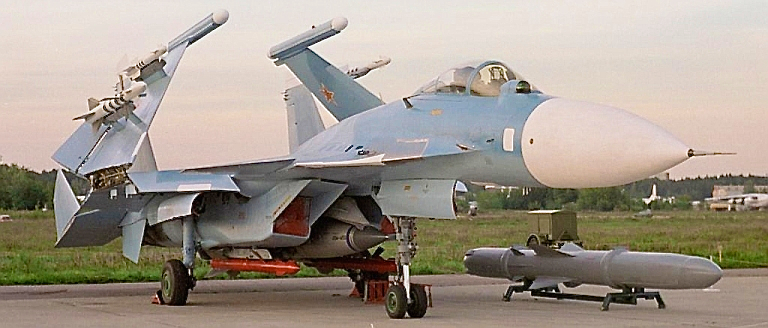Biggest drawback of J-15/Liaoning combination is a fact that J-15 would not be able to use its full payload when taking-off from Liaoning . J-15 originates from Su-33 which was not designed as a naval strike fighter . Soviets were concerned only with air defense and PLAN wants multirole platform .
I'm sorry thunderchief, but you're blatantly wrong here.
You seem to be under the impression that the original Su-33 was designed only for air defence and not with strike capability in mind, and that some kind of inherent deficiency (either avionics or structural) makes the Su-33 unable to carry strike weapons?
I will split your opinion into two parts.
Point A: you believe J-15 is "based off" Su-33, and because the Su-33 wasn't designed to carry strike weapons, then J-15 can't.
Point B: you believe J-15 cannot take off from liaoning with a full payload, therefore it cannot carry heavy strike weapons.
I will address point A first.
Ahem, now, the Russian Navy's Su-33s don't seem able to carry strike weapons, but that is a result of the poor funding of the russian navy being unable to fork out for the avionics and weapons to equip their planes.
That is to say, it is not that the Su-33 which wasn't "designed" as a naval strike fighter, but rather its avionics weren't catered for it. There was nothing inherent in the aircraft preventing it from integrating the avionics to support strike weapons. The aircraft had an MTOW of 33 tons, and the structural strength to support heavy weapons. All it lacks are the avionics.
In fact, Sukhoi has marketed Su-33 with dummies of air to ground weapons, with the associated avionics packages for various customers shoudl they want them.

So, here is Fact One: Su-33 is limited in its ability to conduct strike only because it lacks the relevant avionics.
Now, J-15 is derived from Su-33, correct. In structure, aerodynamics, etc. But in avionics it is completely new. And as I've already said, avionics is the most important determinant of whether an aircraft can conduct strike or not.
Furthermore, we've had pictures of J-15 carrying dummies of anti ship missiles, and dummies of bombs that could very well end up being smart bombs on the real thing. We also have direct words from various state media sources saying the J-15 is meant to conduct precision strike. Finally, we have years of reliable rumours to all but confirm that J-15 is eqiupped with the avionics for strike.
So, here is Fact Two: J-15 is equipped with avionics to carry and launch a number of strike munitions.
Now I'll address Point B, the idea that J-15 cannot take off from a ski jump at MTOW.
There has been much debate over this matter, and I am of the belief that J-15 (and Su-33, Mig-29K, etc) can take off from ski jumps at MTOW, but it depends on the strength of the headwind across the deck which will assist the aircraft in gaining lift.
It is virtually impossible to confirm or deny this matter. It has become a bit of an urban legend of sorts, something we all refer to but with little evidence to support for or against.
However, I translated these few pages of a Su-33s supposed take off loadouts/weights, at various headwinds and ski jump lengths. I suggest you take a read of them.
http://www.sinodefenceforum.com/nav...-programme-news-views-44-6479.html#post247737
So, here is (possible) Fact Three: various aircraft (including Su-33/J-15, Mig-29K) can take off from ski jumps at maximum take off weight with sufficient headwind.
Considering Mig-29K , it looks like this plane could take-off with decent payload from Vikramaditya .
Mig-29K should be able to take off with decent payload from Vikramditya, the same way J-15 can take off with decent payload from Liaoning, as long as both have sufficient headwind.
So I have to ask you, why do you think Mig-29K can but J-15/Su-33 can't?
Is it because Mig-29K is a smaller plane than Su-33? However, I hope you understand that just because a plane is smaller doesn't mean it can automatically take off with more payload. Because while Mig-29K weighs smaller, its engines are also far less powerful.
Assuming both aircraft are taking off under similar headwind conditions, their relative take off weights should be proportional as well -- this is because their T/W ratios are not dramatically different.
Basically what I'm saying is that smaller aircraft (with similar aerodynamics) are not magically able to take off from ski jumps just because they're lighter, because at the end of the day they have less thrust as well.
As Liaoning has longer deck , purely technically speaking Mig-29K/Liaoning combination would be almost perfect (medium sized carrier with medium sized plane) .
Having already dispensed with your idea that only Mig-29K can somehow take off from a ski jump at MTOW while Su-33/J-15 can't, "technically speaking" a Mig-29K/Liaoning combination wouldn't offer any absolute advantages over the current J-15/Liaoning load out, because both J-15 and Mig-29K should be able to take off with their respective MTOWs. So it revert to a simple choice of having less larger and more capable J-15s, vs. more and less capable Mig-29Ks.
---
Here is the take home message:
-Su-33 was only unable to conduct strike because it lacked the relevant avionics (putting it another way, the Russians could easily have made their Su-33s strike capable if they simply had the money to pay for the avionics and the weapons)
-J-15 has the avionics to conduct strike, and it is an accepted fact that the PLAN intend to operate it as a strike aircraft
-With sufficient headwind, J-15/Su-33 (and also Mig-29K) should be able to take off at or near MTOW
-Just because Mig-29K is smaller, doesnt' mean it can take off from a ski jump with proportionally more weight (holding all other variables like headwind, air conditions, constant) than a Su-33 can, because the Mig-29K also has less powerful engines.
Last edited:
